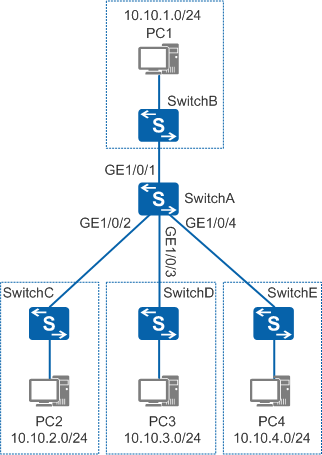Example for Switching an Interface Between Layer 2 and Layer 3 Modes
Overview
Due to hardware restrictions of interface cards, some Ethernet interfaces work in only Layer 2 or Layer 3 mode, whereas other Ethernet interfaces can work in both Layer 2 and Layer 3 modes.
Configuration Notes
- By default, an Ethernet interface works in Layer 2 mode and belongs to VLAN 1. An interface is not removed from VLAN 1 immediately after being switched to Layer 3 mode. It is removed from VLAN 1 only when Layer 3 protocols are Up.
- You can configure Layer 2 and Layer 3 modes of an Ethernet interface in the Ethernet interface view or system view. If the configurations in the two views differ, the latest configuration takes effect.
- The minimum interval between running the portswitch and undo portswitch commands is 30 seconds. That is, after changing the mode of an Ethernet interface, wait at least 30 seconds before changing the mode again.
- If service configurations (such as the port link-type trunk configuration) exist on an interface, clear all service configurations before switching the interface between Layer 2 and Layer 3 modes. The mode switching configuration takes effect on an interface when only attribute configurations (such as shutdown and description configurations) exist on the interface.
- On switches running V200R003 and earlier versions, IP addresses cannot be assigned to Ethernet interfaces in Layer 3 mode.
- Applicable products and versions lists the products and versions to which this example applies.
Networking Requirements
As shown in Figure 1, PC1, PC2, PC3, and PC4 are on four network segments, and SwitchB, SwitchC, SwitchD, and SwitchE are access switches for these four network segments, respectively. It is required that four physical Ethernet interfaces on SwitchA be configured as gateway interfaces for these four network segments.
Configuration Roadmap
The configuration roadmap is as follows:
Change interfaces to Layer 3 mode.
Configure IP addresses of Layer 3 Ethernet interfaces as gateway addresses.
Procedure
- Change interfaces to Layer 3 mode.
# Change an interface to Layer 3 mode.
<HUAWEI> system-view [HUAWEI] sysname SwitchA [SwitchA] interface gigabitethernet 1/0/1 [SwitchA-GigabitEthernet1/0/1] undo portswitch [SwitchA-GigabitEthernet1/0/1] quit
# Change Ethernet interfaces to Layer 3 mode in a batch.
[SwitchA] undo portswitch batch gigabitethernet 1/0/2 to 1/0/4 - Configure IP addresses of Layer 3 Ethernet interfaces as gateway addresses.
# Configure the IP address of GE1/0/1 as a gateway address. The configurations of GE1/0/2, GE1/0/3, and GE1/0/4 are similar to the configuration of GE1/0/1, and are not mentioned here. For details, see the configuration files.
[SwitchA] interface gigabitethernet 1/0/1 [SwitchA-GigabitEthernet1/0/1] ip address 10.10.1.1 24 [SwitchA-GigabitEthernet1/0/1] quit
- Run the display interface gigabitethernet 1/0/1 command in any view to check the interface working mode.
[SwitchA] display interface gigabitethernet 1/0/1 ... Description: Route Port,The Maximum Frame Length is 9216 Internet Address is 10.10.1.1/24 ...
If Switch Port is displayed, the interface works in Layer 2 mode. If Route Port is displayed, the interface works in Layer 3 mode. The preceding command output shows that the interface works in Layer 3 mode.
Similarly, run the display interface gigabitethernet 1/0/2, display interface gigabitethernet 1/0/3, and display interface gigabitethernet 1/0/4 commands on GE1/0/2, GE1/0/3, and GE1/0/4 respectively to check the interface working mode.
Configuration File
SwitchA configuration file
# sysname SwitchA # interface GigabitEthernet1/0/1 undo portswitch ip address 10.10.1.1 255.255.255.0 # interface GigabitEthernet1/0/2 undo portswitch ip address 10.10.2.1 255.255.255.0 # interface GigabitEthernet1/0/3 undo portswitch ip address 10.10.3.1 255.255.255.0 # interface GigabitEthernet1/0/4 undo portswitch ip address 10.10.4.1 255.255.255.0 # return
Applicable products and versions
Series |
Product Model |
Software Version |
|---|---|---|
S5700 |
S5700-EI |
V200R005C00&C01 |
S5700-HI |
V100R005C01, V100R006C01, V200R001C00, V200R002C00, V200R003C00, V200R005C00&C01 |
|
S5710-EI |
V200R002C00, V200R003C00, V200R005C00 |
|
S5710-HI |
V200R003C00, V200R005(C00&C02&C03) |
|
S5720-EI |
V200R007C00, V200R008C00, V200R009C00, V200R010C00, V200R011C00, V200R011C10, V200R012C00, V200R013C00, V200R019C00, V200R019C10 |
|
S5720-HI |
V200R006C00, V200R007(C00&C10), V200R008C00, V200R009C00, V200R010C00, V200R011C00, V200R011C10, V200R012C00, V200R013C00, V200R019C00, V200R019C10 |
|
S5730-HI |
V200R012C00, V200R013C00, V200R019C00, V200R019C10 |
|
S5731-H |
V200R013C02, V200R019C00, V200R019C10 |
|
S5731-S, S5731S-S |
V200R019C00, V200R019C10 |
|
S5731S-H |
V200R019C00, V200R019C10 |
|
S5732-H |
V200R019C00, V200R019C10 |
|
S6700 |
S6700-EI |
V200R005C00&C01 |
S6720-EI |
V200R008C00, V200R009C00, V200R010C00, V200R011C00, V200R011C10, V200R012C00, V200R013C00, V200R019C00, V200R019C10 |
|
S6720S-EI |
V200R009C00, V200R010C00, V200R011C00, V200R011C10, V200R012C00, V200R013C00, V200R019C00, V200R019C10 |
|
S6720-HI |
V200R012C00, V200R013C00, V200R019C00, V200R019C10 |
|
S6730-H |
V200R013C02, V200R019C00, V200R019C10 |
|
S6730S-H |
V200R019C10 |
|
S6730-S, S6730S-S |
V200R019C00, V200R019C10 |
|
S7700 |
S7703, S7706, S7712 |
V200R001(C00&C01), V200R002C00, V200R003C00, V200R005C00, V200R006C00, V200R007C00, V200R008C00, V200R009C00, V200R010C00, V200R011C10, V200R012C00, V200R013C00, V200R013C02, V200R019C00, V200R019C10 |
S7703 PoE |
V200R013C00, V200R019C00, V200R019C10 |
|
S7706 PoE |
V200R013C00, V200R019C00, V200R019C10 |
|
S9700 |
S9703, S9706, S9712 |
V200R001(C00&C01), V200R002C00, V200R003C00, V200R005C00, V200R006C00, V200R007(C00&C10), V200R008C00, V200R009C00, V200R010C00, V200R011C10, V200R012C00, V200R013C00 |

For details about software mappings, visit Hardware Query Tool and search for the desired product model.
